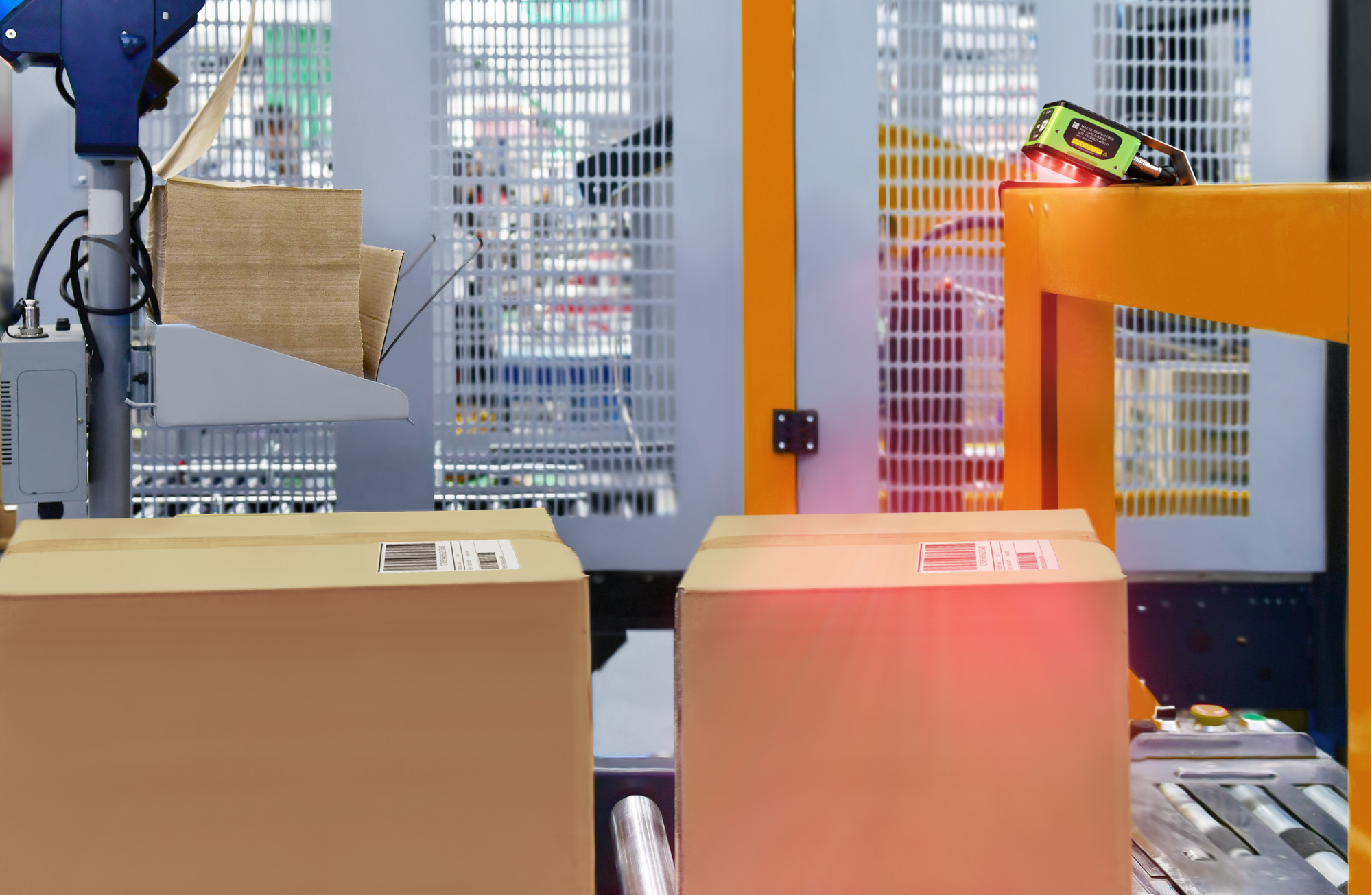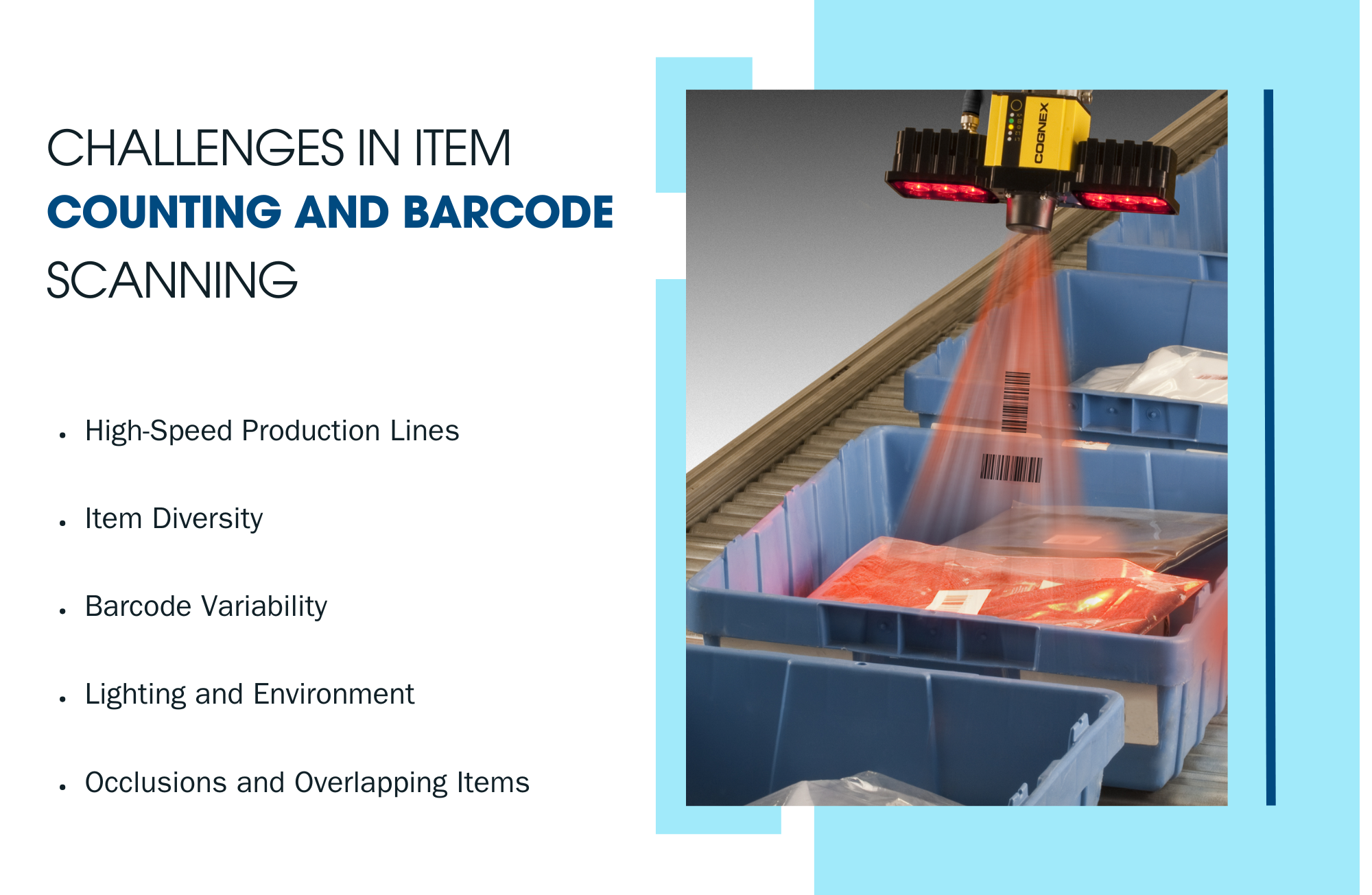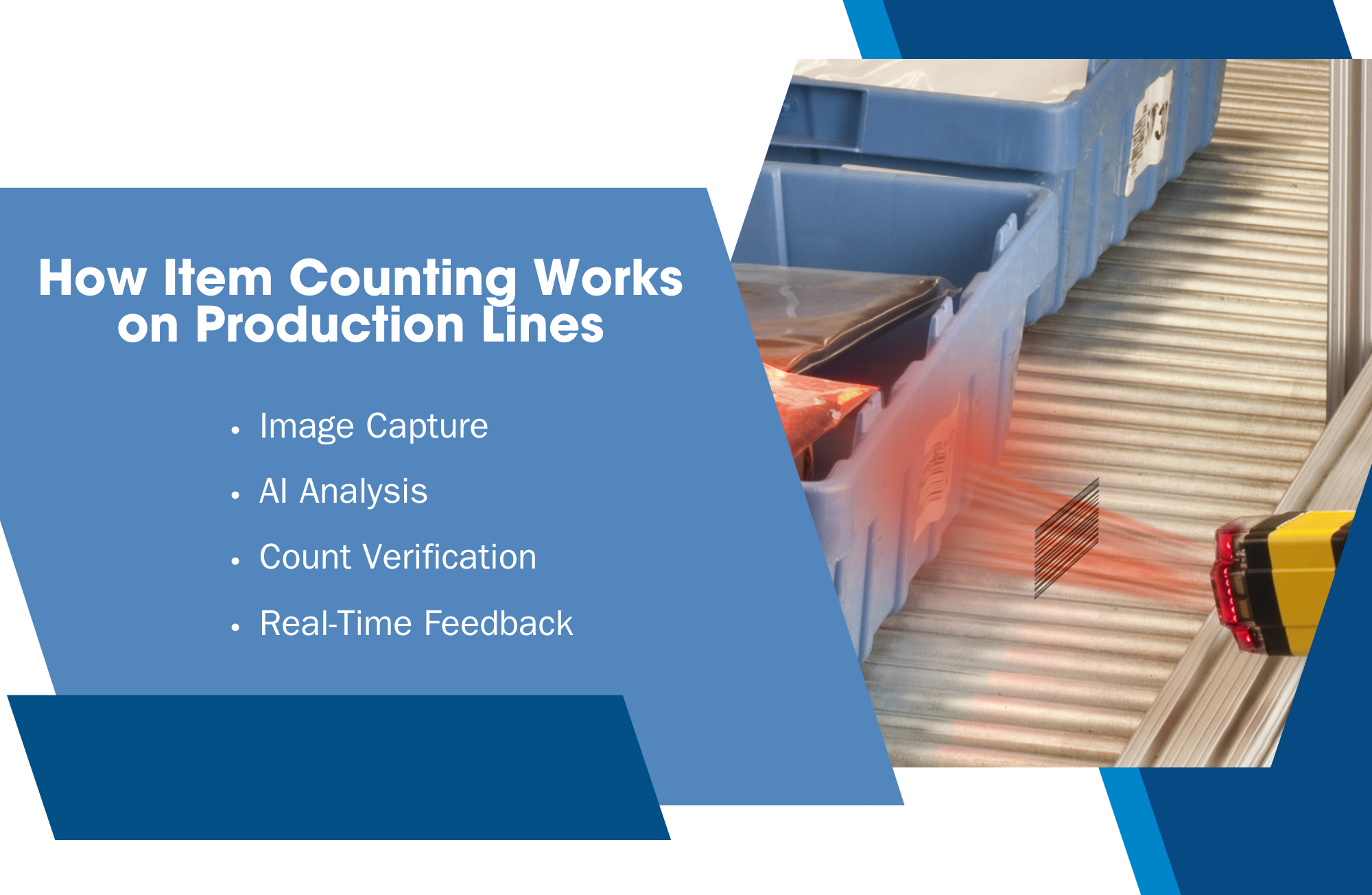Item counting and bar code scanning in production line
Published on: Dec 23, 2024

Written by: Team Intelgic
Item Counting and Barcode Scanning in Production Lines: Leveraging Automation for Efficiency
In modern manufacturing and logistics, item counting and barcode scanning are essential processes that ensure accurate inventory management, seamless workflow, and compliance with quality standards. These tasks, once performed manually, are increasingly being automated using Machine Vision AI, advanced imaging systems, and industrial-grade barcode scanners.

SOP Monitoring: Counting and Barcode Scanning
1. Streamlined Operations
-
Ensures that the correct number of items is packaged, labeled, or dispatched, minimizing errors.
-
Facilitates faster processing in high-speed production environments.
2. Inventory Management
-
Provides real-time data for inventory tracking, enabling efficient stock control.
-
Reduces discrepancies between actual stock and recorded inventory.
3. Quality Assurance
-
Identifies missing, duplicate, or mislabeled items before they reach customers.
-
Enhances traceability, especially for industries with stringent compliance standards.
4. Operational Efficiency
-
Reduces manual labor, improving speed and consistency in production workflows.
-
Supports integration with enterprise resource planning (ERP) and warehouse management systems (WMS).
Challenges in Item Counting and Barcode Scanning
-
High-Speed Production Lines:
-
Items move quickly on conveyors, requiring real-time processing for counting and scanning.
-
-
Item Diversity:
-
Varying shapes, sizes, and packaging materials can make accurate counting and scanning challenging.
-
-
Barcode Variability:
-
Barcodes may be damaged, poorly printed, or located on irregular surfaces.
-
Different barcode types (1D, 2D, QR codes) require versatile scanning systems.
-
-
Lighting and Environment:
-
Insufficient or uneven lighting can impact the visibility of items and barcodes.
-
Dusty, humid, or high-temperature environments can interfere with imaging and scanner performance.
-
-
Occlusions and Overlapping Items:
-
Items that overlap or are partially obscured may lead to counting errors or missed scans.
-

Advanced Technologies for Item Counting and Barcode Scanning
1. Machine Vision Systems
Machine vision systems use high-resolution cameras and AI algorithms to perform item counting and barcode scanning with precision and speed.
-
High-Speed Imaging:
Captures clear images of items and barcodes even in fast-moving production lines. -
Multi-Camera Setup:
Covers wide conveyor belts and ensures all items and barcodes are captured from different angles.
2. AI-Powered Item Counting
-
Object Detection Algorithms:
AI models detect and count items by recognizing shapes, sizes, and patterns. -
Occlusion Handling:
Advanced AI can distinguish overlapping items and count them accurately. -
Real-Time Processing:
Ensures that items are counted instantly, keeping up with production speeds.
3. Industrial Barcode Scanners
Barcode scanners integrated into production lines read and decode various types of barcodes with high accuracy.
-
1D and 2D Barcode Support:
Scans linear barcodes (e.g., UPC, EAN) and 2D codes (e.g., QR codes, Data Matrix). -
Multi-Directional Scanning:
Reads barcodes from multiple orientations, ensuring reliability. -
High-Durability Scanners:
Designed to operate in harsh environments with high resistance to dust, heat, and vibrations.
4. Lighting Systems
Proper lighting enhances the accuracy of both item counting and barcode scanning.
-
Diffuse Lighting:
Minimizes shadows and glare, improving barcode readability and item visibility. -
Directional Lighting:
Highlights surface features for better detection of items on textured or reflective packaging.
How Item Counting Works on Production Lines
-
Image Capture:
Cameras capture images of items moving on a conveyor belt. -
AI Analysis:
AI algorithms detect individual items, distinguishing them from the background and overlapping objects. -
Count Verification:
The system verifies the count and compares it to predefined targets or thresholds. -
Real-Time Feedback:
Alerts are generated if discrepancies occur, such as missing or extra items.

How Barcode Scanning Works on Production Lines
-
Barcode Detection:
Scanners identify the barcode location on the item or package. -
Decoding:
The system reads and decodes the barcode, extracting relevant information such as product ID, batch number, or expiration date. -
Data Integration:
Scanned data is integrated into ERP or WMS systems for tracking and traceability. -
Error Handling:
Alerts are triggered for unreadable or missing barcodes, enabling corrective actions.
Applications of Item Counting and Barcode Scanning
-
Packaging Lines:
-
Ensures the correct number of items are placed in cartons or pallets.
-
Verifies that each package is labeled with accurate barcode information.
-
-
Logistics and Warehousing:
-
Tracks inventory movement with real-time barcode scanning.
-
Counts and validates items during inbound and outbound processes.
-
-
Pharmaceutical Industry:
-
Ensures accurate counting and labeling of medicine bottles, blister packs, or vials.
-
Scans barcodes for compliance with serialization regulations.
-
-
Food and Beverage Industry:
-
Verifies packaging counts and barcode accuracy for perishable goods.
-
-
Electronics Manufacturing:
-
Tracks components through assembly lines with barcode scanning.
-
Counts items like circuit boards or chips to ensure completeness.
-
Benefits of Automating Item Counting and Barcode Scanning
1. Improved Accuracy
-
Eliminates manual errors in counting and barcode reading.
-
Ensures 100% accuracy even in high-speed operations.
2. Increased Efficiency
-
Automates repetitive tasks, reducing reliance on manual labor and improving throughput.
3. Real-Time Insights
-
Provides real-time data on production counts and barcode information, enabling better decision-making.
4. Cost Savings
-
Reduces losses due to miscounts, incorrect labeling, or stock discrepancies.
5. Scalability
-
Adapts to diverse production lines, handling various item sizes, shapes, and barcode types.
Intelgic’s Expertise in Item Counting and Barcode Scanning
At Intelgic, we specialize in designing and deploying custom Automated Optical Inspection (AOI) systems for item counting and barcode scanning. Our solutions integrate advanced imaging technologies, AI algorithms, and industrial-grade scanners to deliver precise and efficient results.
Key Features of Intelgic’s Systems
-
High-Speed Processing:
Keeps up with even the fastest production lines. -
Versatile Integration:
Supports various item types and barcode formats. -
AI-Driven Precision:
Ensures accurate counting and scanning with advanced defect detection capabilities. -
Durable Design:
Built to withstand harsh production environments. -
Real-Time Feedback:
Alerts operators immediately for discrepancies or errors.
Automating item counting and barcode scanning in production lines is essential for achieving operational efficiency, accuracy, and reliability. By leveraging advanced technologies like Machine Vision AI, high-resolution imaging, and industrial barcode scanners, manufacturers can streamline workflows, reduce errors, and ensure compliance with quality standards.
Intelgic’s tailored solutions for item counting and barcode scanning empower manufacturers to optimize their production processes and maintain a competitive edge. Contact Intelgic today to learn how our systems can revolutionize your production line operations.

